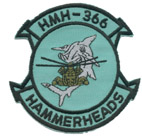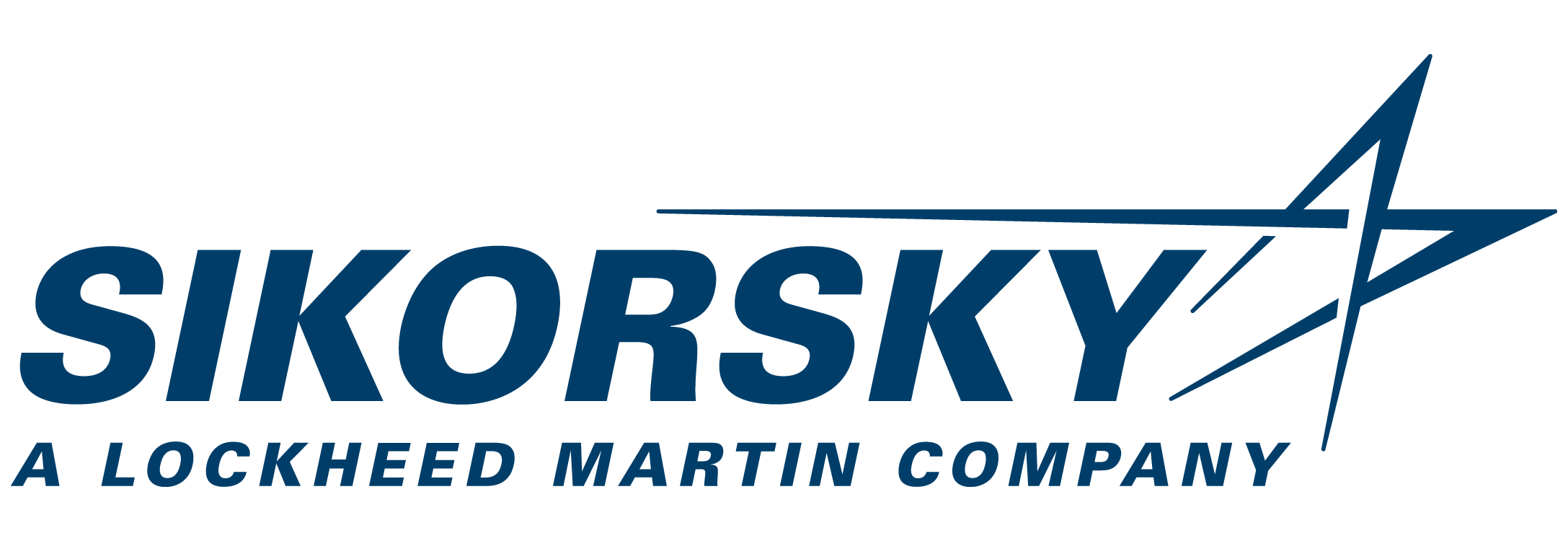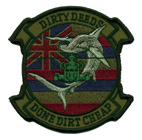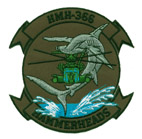
HMH-366 Squadron Patch
History of HMH-366
Marine Heavy Helicopter Squadron-366 (HMH-366) was originally activated on 30 September 1994 at MCAS Kaneohe Bay, Hawaii. As the fourth active CH-53D Sea Stallion squadron, it was the only Hawaiian home-grown helicopter squadron in active service in the Marine Corps.The squadron’s callsign”Hammerhead,” was inspired by the fact that Kaneohe Bay is home to the world’s largest hammerhead shark population, and the original unit patch featured a hammerhead shark leaping over an airborne CH-53D.
While active in Hawaii, the squadron deployed to the Pacific Missile Range Facility (PMRF), Barking Sands on Kauai, the PohokoluaTraining Area on the Big Island, and completed a successful mainland deployment in support of Combined Arms Exercises (CAX) 9-98 and 10-98, and Weapons and Tactics Instructors Course (WTI) 2-00. The squadron also supported a four aircraft deployment to Dhaka, Bangladesh for presidential support of President Clinton’s visit to the country.
On 1 October 2000, with a limited number of available CH-53Ds in the Marine Corps, and no addition CH-53Ds being produced, the squadron was de-activated as part of a realignment plan to redistribute the units’personnel and aircraft to the remaining three CH-53D squadrons in Hawaii (HMH-362, HMH-363, HMH-463), thereby increasing the Primary Authorized Aircraft (PAA) of those squadrons from eight to ten aircraft.
366In January 2007, the President of the United States, on the recommendation of the Secretary Defense, announced that the Marine Corps would increase its end strength from 175,000 to 202,000 Marines by 2011. This increase is needed to provide adequate time to recover between deployments, train to meet combat readiness, and preparefor redeployment. The purpose of the this action is to ensure that Marines are properly prepared and trained for existing combat and homeland protection missions and future conflicts.
As part of this growth plan, it was determined through a HQMC study that additional heavy lift capabilities would be required in order to support the added personnel and equipment inherent to this growth.
In early 2008 the Marine Corps started transferring reserve CH-53 aircraft and personnel to active status as a precursor to the planned decommissioning of HMH-769 from the reserve forces. These aircraft, and personnel, along with the forward staffing of selected individuals from around the fleet by HQMC, formed the basis for the development of the CADRE and activating unit that is present today.
Over the past six months, this group has worked together from the ground up, to build the infrastructure of this unit, and posture the command for a successful activation and to achieve Initial Operational Capability (IOC) on 1 Oct 2008. The Squadron is activating with 140 Marines, and8 Aircraft, and will continue to grow over Fiscal Year (FY) 2009, reaching Full Operational Capability (FOC) with 16 aircraft, and over 300personnel by 4thQTR FY09.
HMH-366 was selected as the name for the Marine Corps seventh CH-53E squadron, because it was the only active duty HMH to have been previously decommissioned. The name Hammerheads is also fitting, because one of the largest populations of hammerhead sharks on the East Coast is off of North Carolina. The original squadron patch wasmodified to replace the CH-53D with a CH-53E, and the colors were changed to reflect those of the North Carolina State Flag.
The squadron has also adopted the original motto of the Hammerheads: “NO’U KAPONO, O KO’U, MAHELE KOA”, which translated means: The Honor of my squadron in my own.


